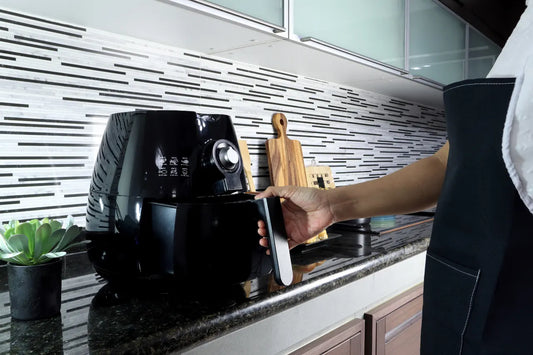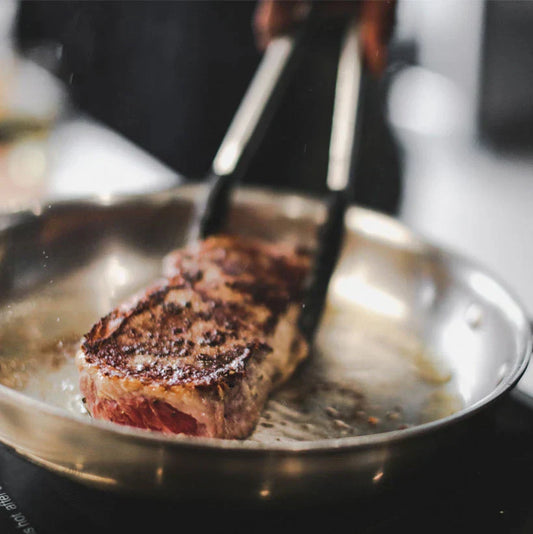Probably the most commonly reached-for pan in any home or restaurant kitchen is the fry pan. Whether you’re frying up breakfast eggs, preparing a grilled cheese sandwich for lunch, or cooking a steak for dinner, a good quality stainless steel fry pan is an irreplaceable part of your cookware collection.
What are Stainless Steel Fry Pans: The Basics
There are, of course, many manufacturers of stainless steel fry pans, with their products varying in quality and cost. Before buying one, it’s a good idea to shop around and compare the construction of the different pans.
For instance, 360 Cookware fry pans, manufactured in the United States, are made from stainless steel wrapped around an inner layer of aluminum. The aluminum core conducts the heat evenly, while the T-316 surgical grade stainless steel on the inside provides a smooth non-toxic cooking surface. The outer shell is T-400 stainless steel, suitable for gas, electric, or induction burners.
Because the aluminum core is completely sealed off, you get both the excellent heat conduction characteristics of aluminum, while not having to worry about the potential harm of aluminum leaching into your food. A stainless steel fry pan is easy to clean and can easily last a lifetime, eliminating the expense of replacement.
Why Use Stainless Steel Fry Pans Instead of Nonstick or Ceramic?
Safety
Social media influencers certainly seem to like their nonstick or ceramic fry pans, as you’ll see when scrolling through Instagram or TikTok. Teflon-coated pans have been around for more than 50 years, but there are now newer types of nonstick pans available as well. Their cooking surface is coated with chemicals which promise a slick surface that food will not stick to as it cooks. While new pans are free of PFOA, a toxic “forever chemical”, they may still contain PTFE, another “forever chemical” that can be released when the pan is exposed to high temperatures, or the coating gets scratched.
Ceramic pans are the newest pans on the market, and claim to be safer, but the coating can still present a risk. In this case, the cooking surface is coated with a layer of silicon dioxide (silica) and cured at a high temperature to create a slick, glassy surface. It sounds perfect, especially when these pans are available in a range of trendy colors to complement your kitchen décor. However, while the ceramic coating is primarily silicon, an inert material, manufacturers are not transparent about other, more problematic, additives they may include in the coating formulation.
Longevity
In addition to safety concerns, a big drawback to both nonstick and ceramic pans is their longevity (or lack of it!). Even with the greatest of care, their coating is not going to last forever. Chips and scratches can release their chemicals into your food as it cooks, and over time under normal use, the surface will become abraded and worn, becoming less slick even as they increase the risk of toxins being released. You can expect to have to replace a coated fry pan in as little as a couple of years, with five years being the longest that it should be used before purchasing a new one. In contrast, a stainless steel fry pan can easily be expected to last you a lifetime.
Cooking Techniques
If you crave a good, crispy bottom to your fried eggs, or a caramelized sear on your pan-fried steak, you’re not going to get that with a nonstick or ceramic fry pan. Because their surface is engineered for food not to stick, you never get a properly seared or crispy texture. On the other hand, a stainless steel fry pan will give you that desirable crusting, but never fear, once the food is sufficiently cooked, it will release naturally from the pan. Stainless steel fry pans also move seamlessly from the stove top to the oven making them a more versatile choice.
Yes, You Can Cook Eggs in a Stainless Steel Fry Pan- Here’s How!
While the cooking surface of a stainless steel fry pan is uncoated, you can easily turn it temporarily into a nonstick pan without having to worry about adding toxins to your food. This technique will allow you to fry eggs to perfection and have them slide out onto the plate with no trouble.
Before even pulling out your fry pan or turning on your burner, start whenever possible with room-temperature ingredients. When you add cold ingredients to a hot pan, the resulting drop in temperature can create a less slick surface, leading to the increased risk of food sticking to the pan. So let your eggs, fish or steak sit out on the counter for half an hour before you start frying.
When you’re ready to start cooking, set your stainless steel fry pan on a burner over medium heat, and (this is key!) wait for it to heat up before adding oil or butter. This will take 2 or 3 minutes, and there’s an easy way to tell when the pan is hot enough to proceed. Sprinkle a few drops of water over the surface, and see what happens. If the drops flatten out and evaporate, it’s not hot enough. However, if the droplets bounce around the pan, you’re good to go. Blot up any remaining water, and add just a thin coat of oil to the pan. Once it starts to shimmer, it’s time to add your food. While things may initially seem stuck, be patient and wait for the eggs, fish, or steak release naturally from the surface once a tasty crust has formed.
Wrapping Up
Thinking of buying a new fry pan or two? Consider the advantages of stainless steel:
- Safety: with no coating to degrade or chip, you’re assured that you won’t be adding toxins to your food
- Versatility: whether you want to cook eggs without sticking, or sear a chicken breast to crispy perfection, you can achieve that in a stainless steel fry pan
- Economy: while a quality stainless steel fry pan may cost more initially, it’s going to last you for life, whereas a coated nonstick or ceramic pan will need to be replaced every few years
Be like professional chefs and serious home cooks- choose stainless steel fry pans for the best and safest cooking experience!




